Port Gardner map















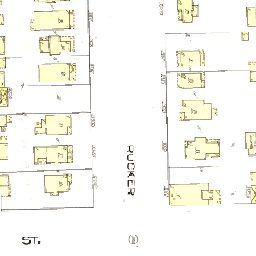
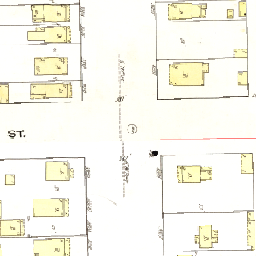





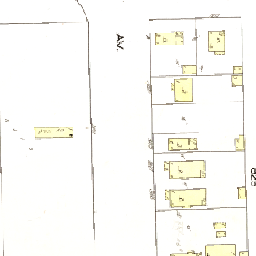









Welcome to Port Gardner Neighborhood! The boundaries for this website exclude the central business district -- we focus on Pacific Ave to 41st St, from bayside to riverside.
Pick a street of interest, and while walking compare the old photographs with today.
Other neighborhood tours Charles and Edward were the sons of Everett pioneer Frank Friday. Sevenich family who arrived in Everett in the 1920s. Paul Sevenich purchased the local Chevrolet auto dealership and ran it as Sevenich Motors for decades. He was very active in the community.| E-W | N-S |
|---|---|
| Pacific Ave | Tulalip Ave |
| 32nd St | Federal Ave |
| Snohomish Ave | |
| Kromer Ave | |
| Bell Ave, named for James Bell, of Bell-Nelson mill, and Everett mayor. | |
| Gedney Ave | |
| Nassau St | |
| Friday Ave | |
| Norton Ave | |
| Laurel Dr | Grand Ave |
| 33rd St | Rucker Ave |
| Hoyt Ave | |
| Edward Ave | Colby Ave |
| Wetmore Ave | |
| Rockefeller Ave | |
| Oakes Ave | |
| Lombard Ave | |
| Broadway Ave | |
| McDougall Ave | |
| Paine Ave | |
| Smith Ave | |
| Pine St |






























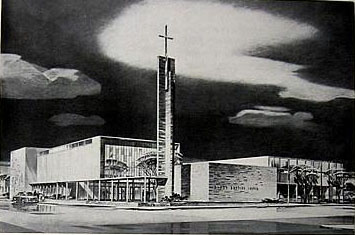
Architects: Durham, Anderson and Freed. Builders: Newland Construction. Cost: $600,000.
First service was Palm Sunday, April 10, 1960 by pastor Carlton Goodwin. The sanctuary seated 700 people and could accommodate two choirs. The church school unit had rooms for each age and grade level. The windows, by Bagriel Loire Studios of Chartres, France were made using chipped glass in cement. There was also a bride's room and social hall that could seat 450 for dinner. The organ dated from 1914 but a third more pipes were added. At that time, there were plans for a chapel and tower in the court area, and more classrooms on the second floor.
Jack O'Donnell collectionArchitect: Charles Hove.
To promote the new city, one of the earliest and definitely the most ambitious building was the Monte Cristo Hotel. Originally it was to be named for Charles Colby, but he declined. It was named for the gold mining district 38 miles east in the Cascade Mountains, which surely would provide riches as fantastic as in the popular novel of the time, "The Count of Monte Cristo" by Alexander Dumas. (It did not; Monte Cristo is now a ghost town requiring a four mile hike to visit.) Eastern industrialists with funds from John D. Rockefeller were rushing to complete the railroad between the two towns, completed in 1893. The hotel would be perfect for the Rockefeller syndicate for lavish events.
The U-shaped hotel had 75 sleeping rooms, a billiard parlor, saloon, barber shop, 36 x 40 foot kitchen, 40 x 50 foot main dining room, a gentleman's private writing room, and a ladies' parlor with fireplace and piano.
The magnificent hotel was designed by Charles Hove, who lived at now-gone 3020 Kromer Ave in a house he also designed. Hove was born near Hamburg, Germany in 1849, the son of a carpenter. At age 23 he fled conscription to army and arrived in Chicago where he spent a year and a half before going to Milwaukee. He arrived in Tacoma in 1889 and designed buildings for Henry Hewitt, a founder of Everett. In 1891 he founded a partnership with August Franklin Heide and the firm became architects for the Everett Land Company. In March 1893 the partnership dissolved. In fall 1915 he was attacked and killed by a bull on his farm. Hove is buried in Everett's Evergreen Cemetery. Jack O'Donnell research
David Clough lived here in 1903.
In May 1904, the hotel was purchased for $50,000 by the Sisters of Providence, to become their hospital. It had 75 beds, starting with 11 Sisters and 3 employees. Major events for the hospital include receiving 8 victims of the Everett Massacre in 1916 and many victims of the Spanish Flu in 1918.
In 1924, the young building was torn down shortly after a new hospital was built just to the east. The sisters intended to build a modern nurses home on the hotel site, but it was built further south on Nassau. Torn down by the Healy Company, the Healys recycled many of the materials with some glass panels going as far as California. They provided 500 bricks that were scattered amongst the bricks of a new Monte Cristo Hotel, built on Wall Street in 1925.
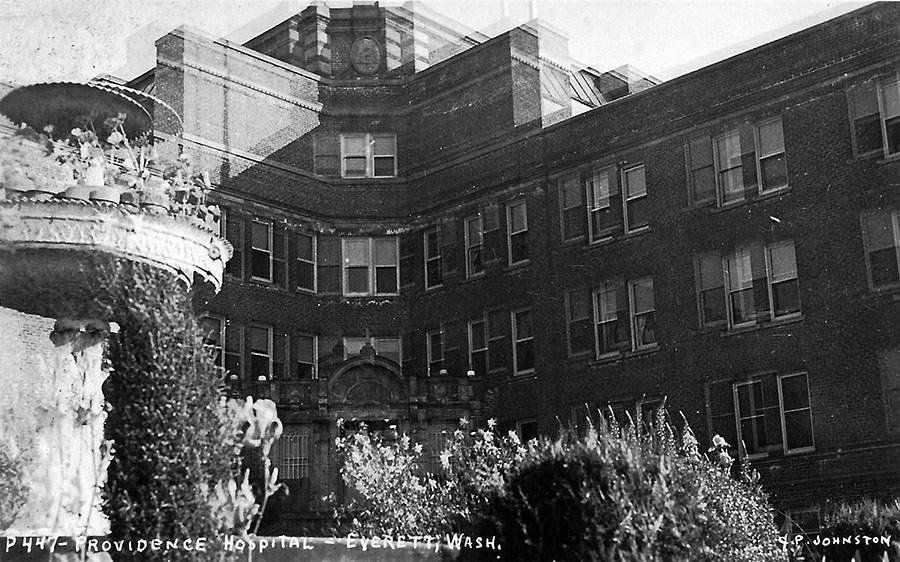
 Note the Rucker Mansion in the background.
The Livingstons and some of their children are in the picture from about 1905-07:
Ida, Alice (never married 11-29-01 – 10-23-64), Thomas, Hilda, Myrtle (never married 11-29-01 – 10-23-64), Mrs. Martina Livingston.
Livingston family collection collection
Note the Rucker Mansion in the background.
The Livingstons and some of their children are in the picture from about 1905-07:
Ida, Alice (never married 11-29-01 – 10-23-64), Thomas, Hilda, Myrtle (never married 11-29-01 – 10-23-64), Mrs. Martina Livingston.
Livingston family collection collection
The Livingstons lived here remarkably until 2000, nearly a century. Ida, Alice (never married 11-29-01 – 10-23-64), Thomas (father), Hilda, Myrtle (never married 11-29-01 – 10-23-64), Martina. Leonard never married, lived much of his life on nearby Gedney (Hat) Island (3-13-11 – 9-5-90).
Note: Originally at 3110 Tulalip, the house is now at 3030 Tulalip. It's possible the house was slightly moved due to being over the property line. The original house was turned 90 degrees clockwise. The front door was changed. Where the old front porch was a room was added. The two front windows were replaced with one big window and a new front door. The upstairs window is the same. There was another remodel in the 1990s.
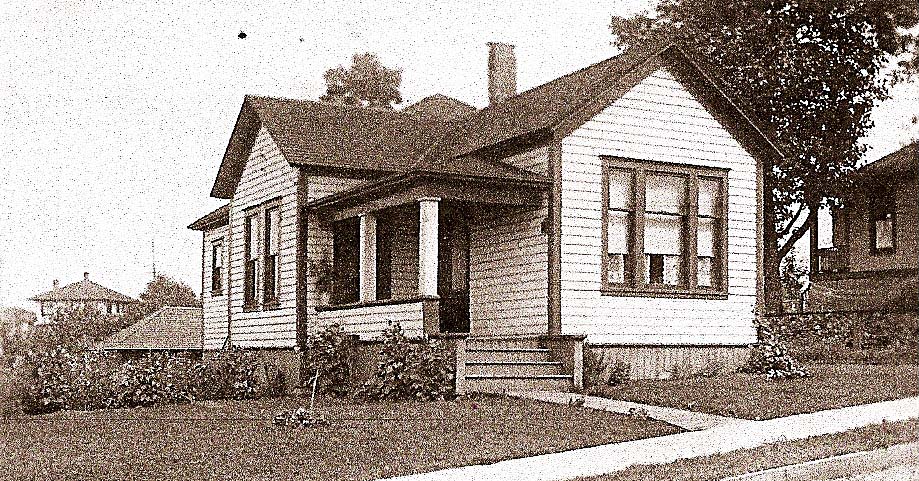 1916.
Larry Wold collection
1916.
Larry Wold collection
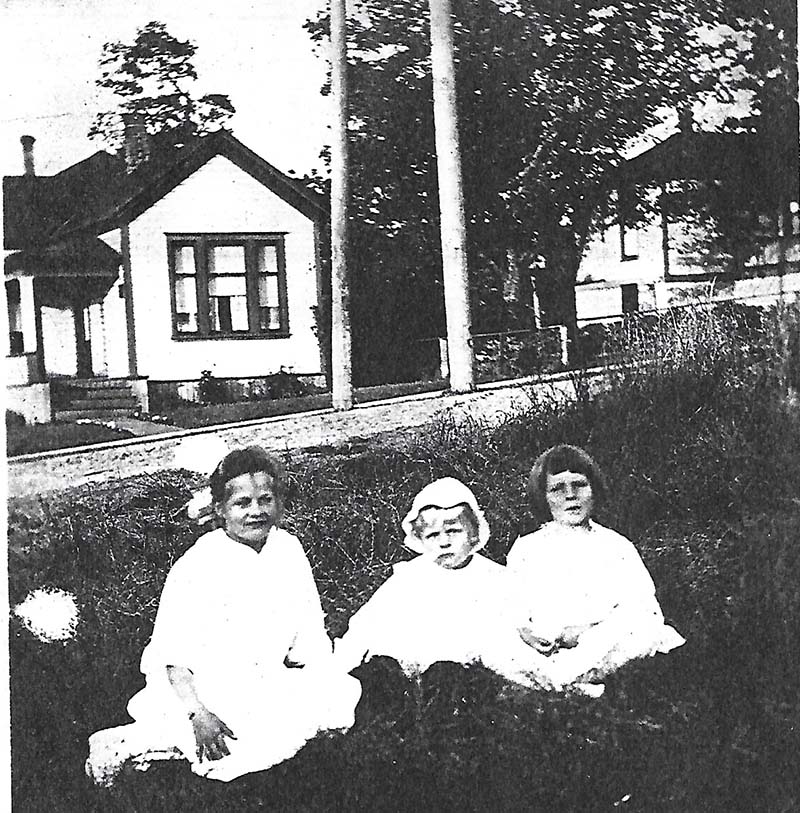 3111 Tulalip across the street.
Jack O'Donnell collection
3111 Tulalip across the street.
Jack O'Donnell collection
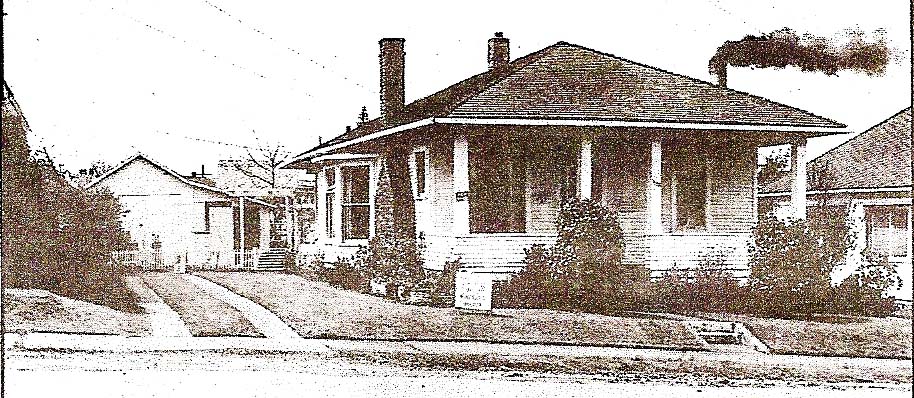 1964.
Home of Glenn, Cathern, Larry and Jack O'Donnell in the 1940s.
Jack O'Donnell collection
1964.
Home of Glenn, Cathern, Larry and Jack O'Donnell in the 1940s.
Jack O'Donnell collection
Built by C. P. Spreisterbach
Capt. Ramwell lived here in the early 1900's, certainly in 1907. Powerful force on the Everett Waterfront, president of American Distributing Co., American Ice & Cold Storage and American Pile Driving Co. and Everett Sand & Gravel Co., and manager of American Tug Boat Co. American Construction was an affiliated company. More about Ramwell is on HistoryLink.
 William Vincent
William Vincent
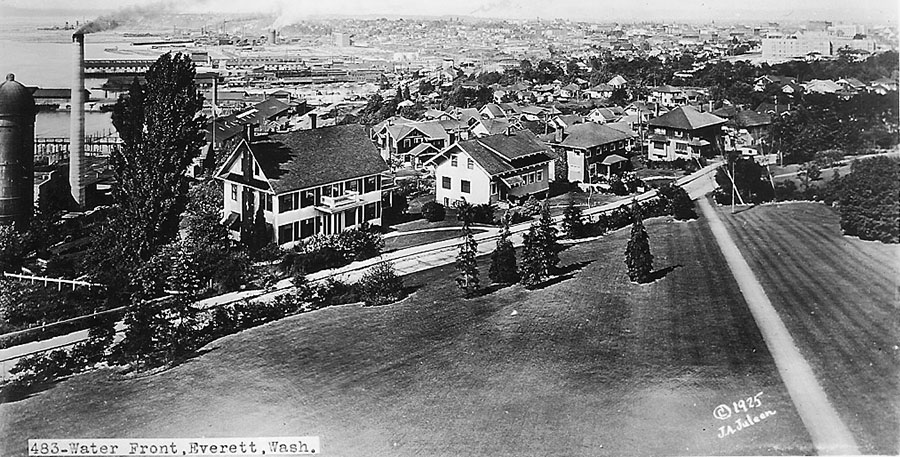
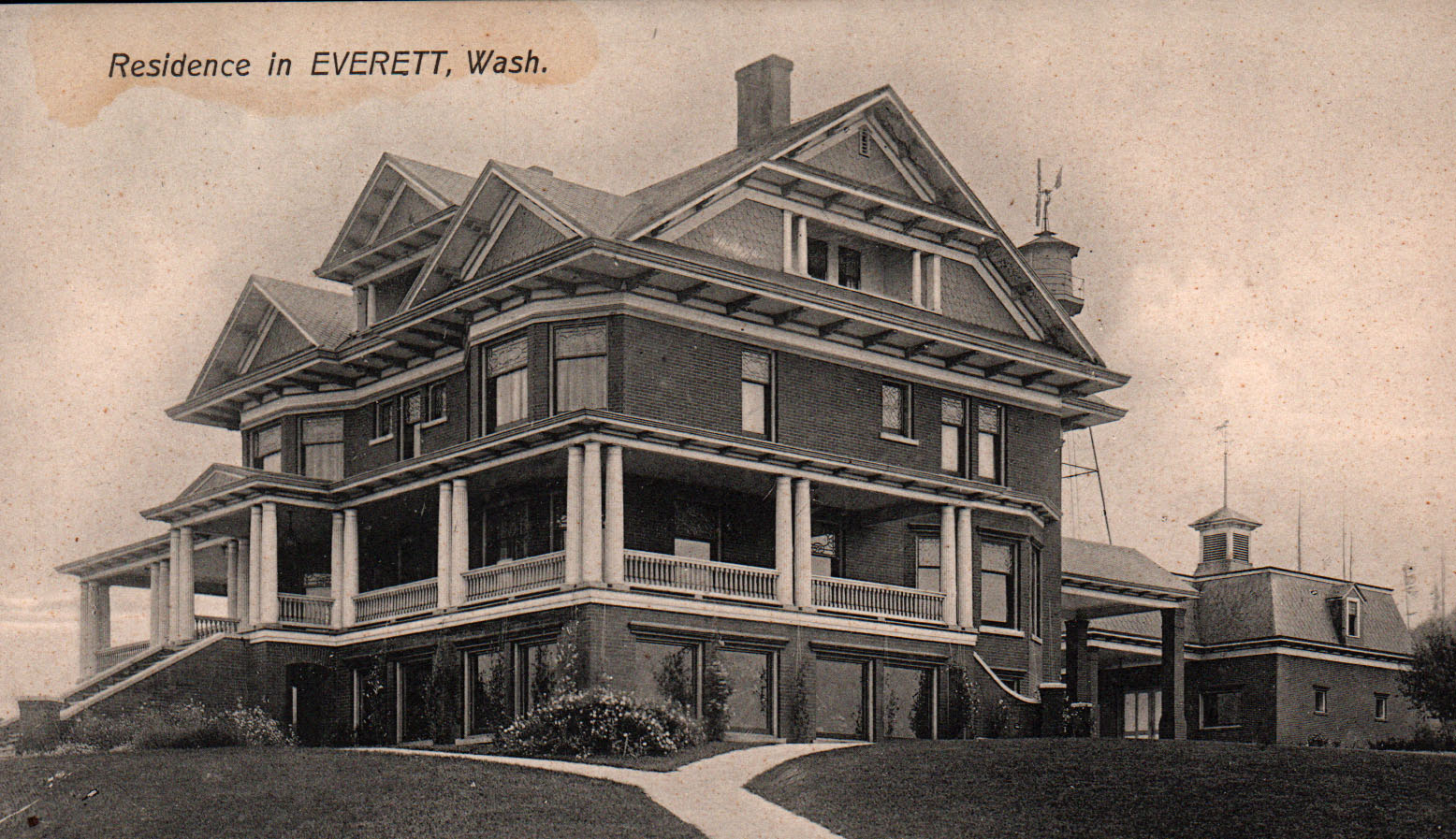
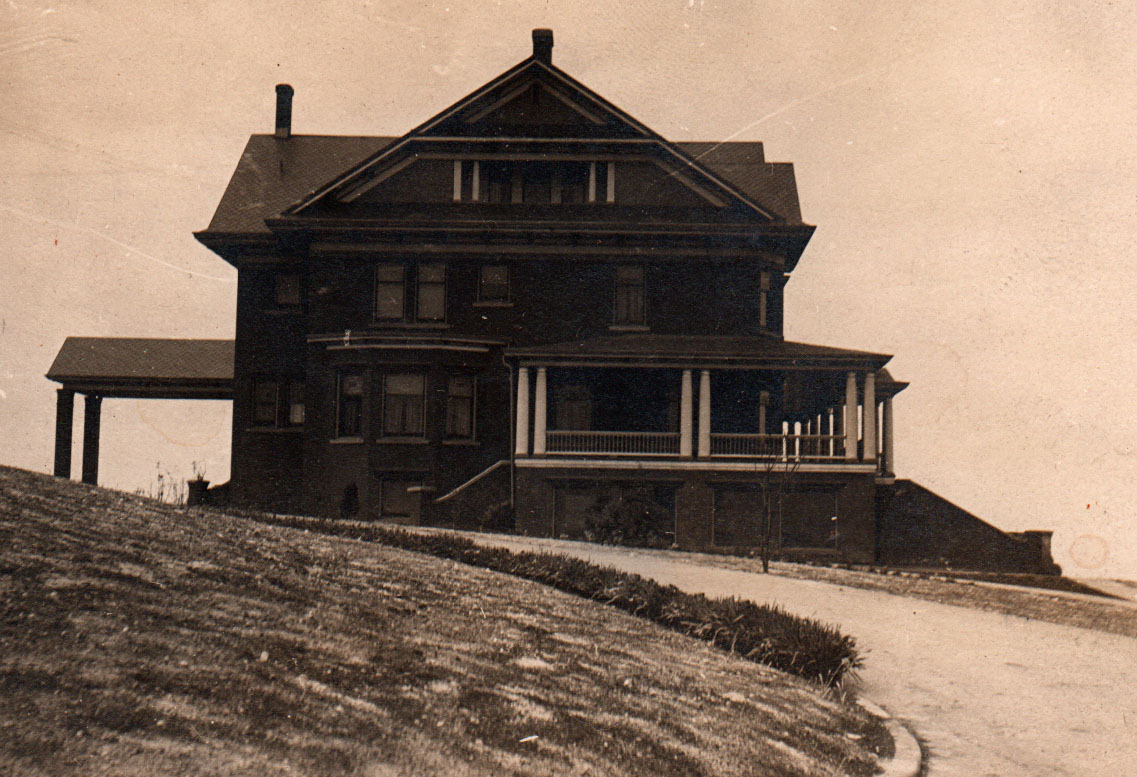
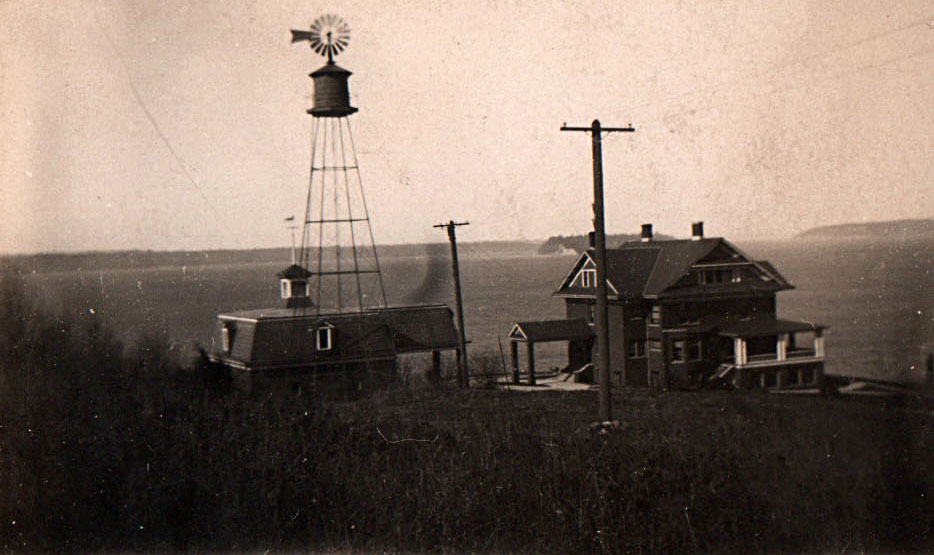 1908.
Jack O'Donnell collection
1908.
Jack O'Donnell collection
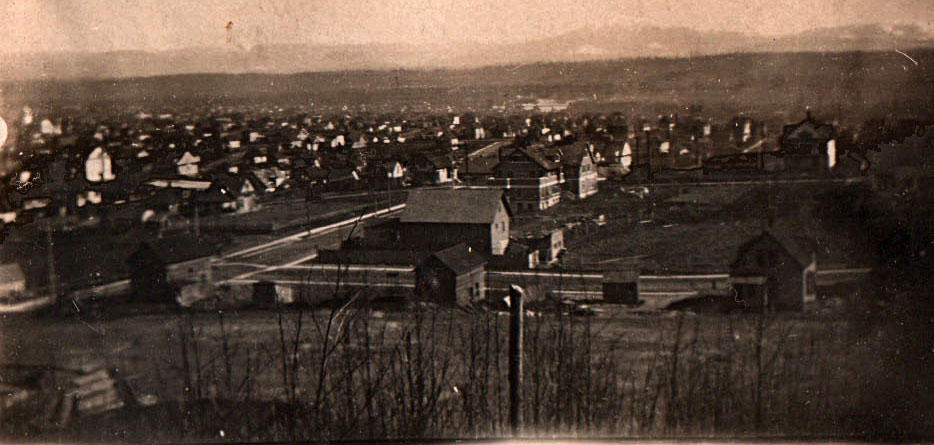 1908, a view from Rucker Hill.
Jack O'Donnell collection
1908, a view from Rucker Hill.
Jack O'Donnell collection
National Register
This is the boldest, biggest mansion in old Everett, built for Bethel Rucker (1862-1945) and his new wife Ruby Brown Rucker. His mother, Jane Rucker also lived here but died 2 years after they moved in. Wyatt Rucker moved in at the same time. Their pyramid-shaped monument to her is the largest in Evergreen cemetery, and the iconic tomb in the city. Naturally, this was big news when built (see Heralds October 17, 1904, April 15, 1905, July 1, 1905). The 1904 article mentioned several hundred visited the construction site, and everyone had their own opinions. In those days, you would take the winding Laurel Drive all the way up to the mansion. Today it's interesting to see the Laurel signs taking such a circuitous path.
Bethel Rucker was a pharmacist from Ohio. He moved to Seattle in 1886, and arrived in the Everett vicinity in 1889. The Ruckers started a plat for a town called Port Gardner. They were in the area before eastern industrialists (Rockefeller, Colby, Hewitt, etc.) and the railroad (Jim Hill) quietly bought up land here. The Ruckers joined in this venture, rather than starting their new city. They became wealthy as Everett boomed, involved in a lumber mill, a bank, and real estate. Later they took over the Everett & Monte Cristo railroad, and built the Big Four Inn. Please see this HistoryLink article on one of the most influential Everett founders.
The 13,000 sq ft house, full of mahogany and quarter sawn oak woodwork, has five fireplaces, library, card room, billiards room, solarium, ballroom, six bedrooms and bathrooms, carriage house... cost $40,000 to build. More on the Ruckers.
The Ruckers traded their 17 year old house to the Clyde and Nora Walton family in 1923 for $32,000 and the 2601 Hoyt house (see Apr 7, 1923 Herald). Walton was a lumber baron, and lived here until 1959. Their mill was where the current Riverfront homes are now.
Clyde (1876-1959) was an avid horseman, and had the stables renovated. He would ride from his property towards Forest Park. The Waltons didn't alter the mansion very much.
Nora (-1958). See April 7, 1958 Herald, p.10.
The house was purchased by Dr. Glen Ogden who lived there a couple of years. In 1964-73 Robert Young, president of Everett Trust and Savings, bought it and did some remodeling.
In 1974, the city of Everett signed an option to purchase the house for $70,000, and create a museum. (Herald, June 15, 1974). But neighbors opposed the museum idea. City Councilperson Joyce Ebert's family decided to purchase it.
Joyce Ebert (1922-2004) lived here with her husband Dr. Bill Ebert(-2002) and four children . Joyce was heavily involved in city culture, including Snohomish County Historical Society, Immaculate Conception parish, the Everett Assistance League, and the Everett Golf and Country Club. She became a real estate broker.
She was the first woman on the Everett City Council, in 1973. For a couple months in 1977 she was interim Mayor of Everett, and the first Washington native to become mayor.
The Eberts were responsible for putting the house on the National Register of Historic Places in the mid-1970s. See Oct 27, 1975 Herald.
The property was empty for awhile Davis and Carol Brandvold bought the mansion on December 31, 1992 for $700,000. See Rucker Family Society newsletter and May 23, 1993 Herald. They did a lot of work removing some of the 1960s and 1970s interior alterations, restoring it to its former look. They gave it a good cleaning, repaired paint spots on the beautiful oak floors. They intended to open it as a bed and breakfast.
Once again, the house was in danger of being razed. Bob and Brenda Kerr purchased the mansion in 1997 for $650,000. The do-it-yourselfers restored much more of the interior and exterior, hand laying tile and cleaning out century-old cedar gutters. They remodeled the kitchen in a style sensitive to the house. See September 8, 2005 Herald. See December 21, 2006 Herald for their Christmas decorating. See April 23, 2020 Herald for-sale article.
The house combines elements of Italian Villa, Queen Anne and Georgian Revival styles.
The surrounding area is part of the Rucker Hill Historic District
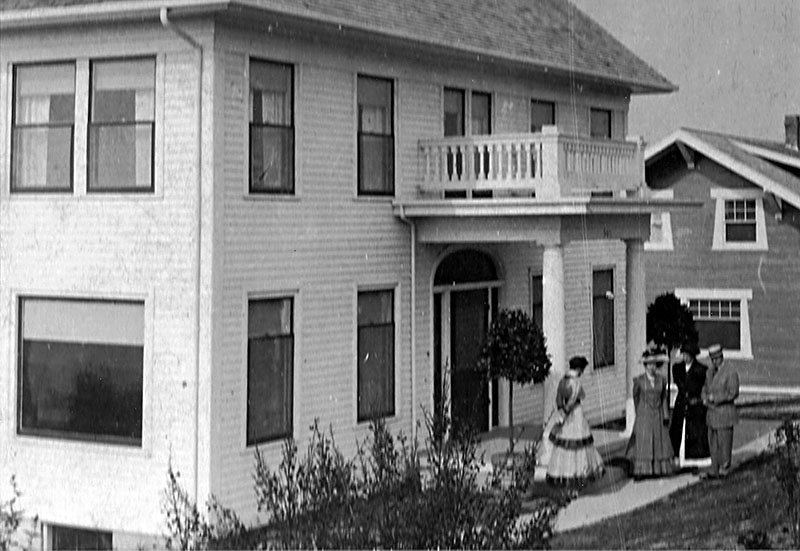
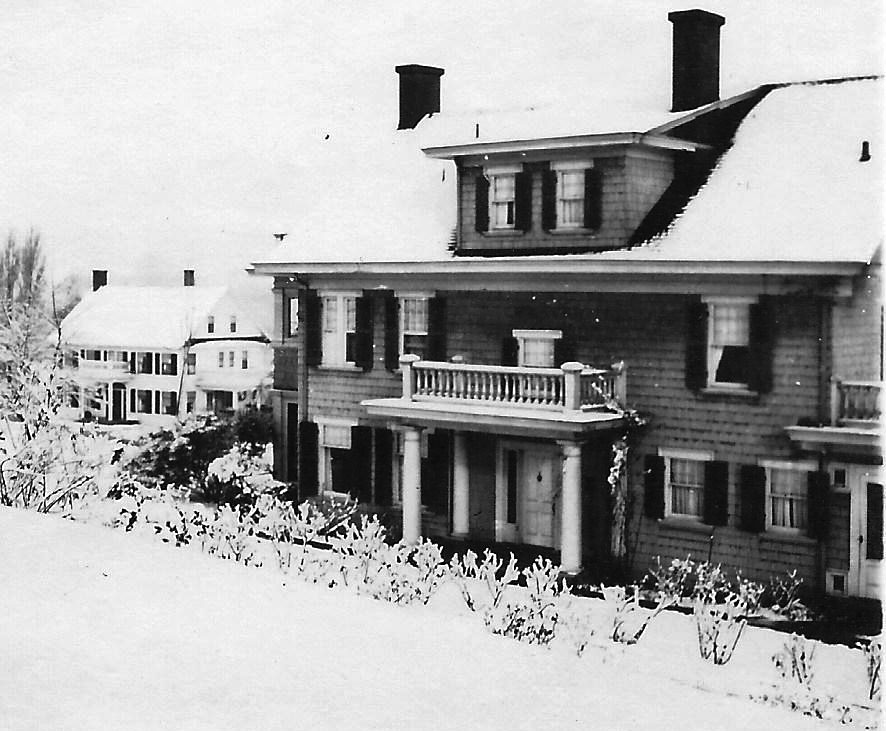
See also Herald Jan 14, 1936 article, "P.J. Sevenich is Head of Big Firm on Rucker Avenue."
On March 7, 1960, this Seiffert Oil Truck was parked while Nelson Clark was pumping oil to another house. But the truck slipped its brakes and slowly rolled into the Richard Walton house at 515 Laurel, nearly going through the plate glass window. Mrs. Walton was in the basement and thought it was an earthquake. Marjorie Duryee's first photo in this collection made the Everett Herald.
Photos by Marjorie Duryee
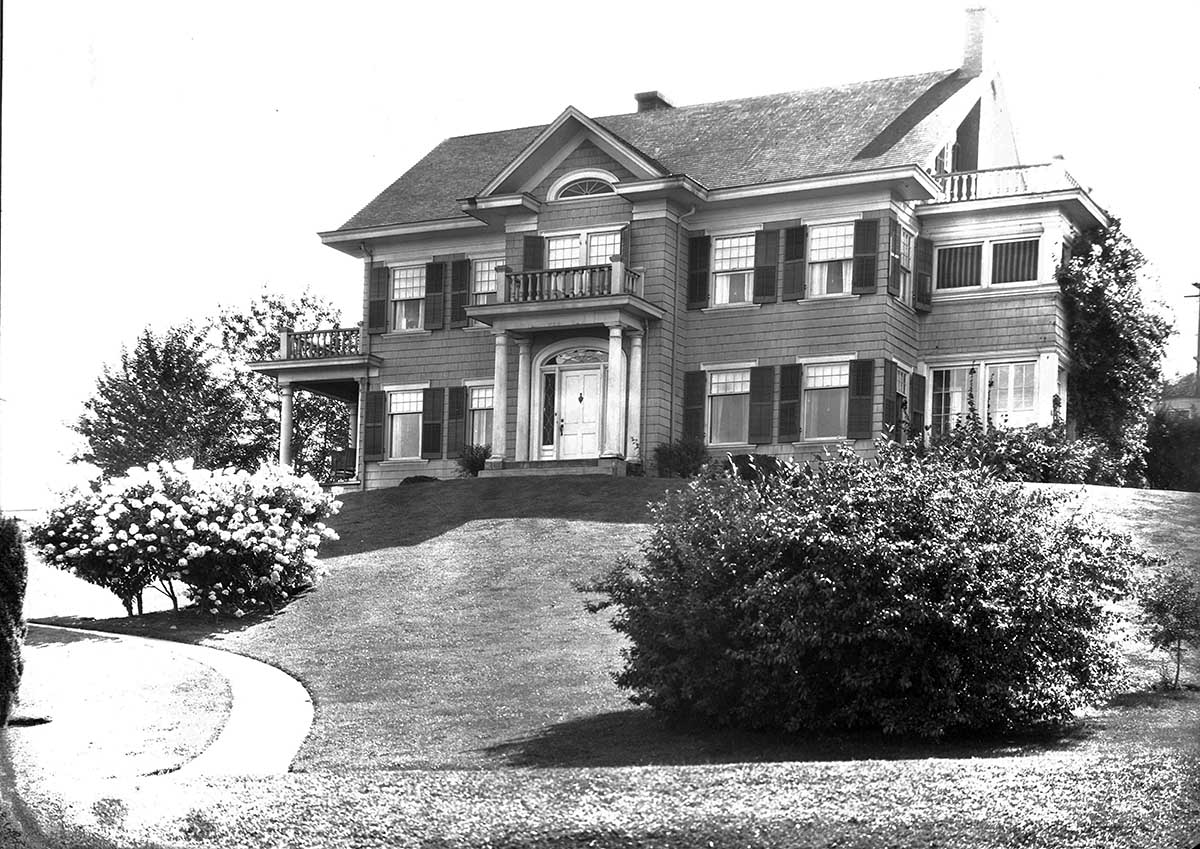 During the Jack Coleman residency.
Everett Public Library, Juleen 472
During the Jack Coleman residency.
Everett Public Library, Juleen 472
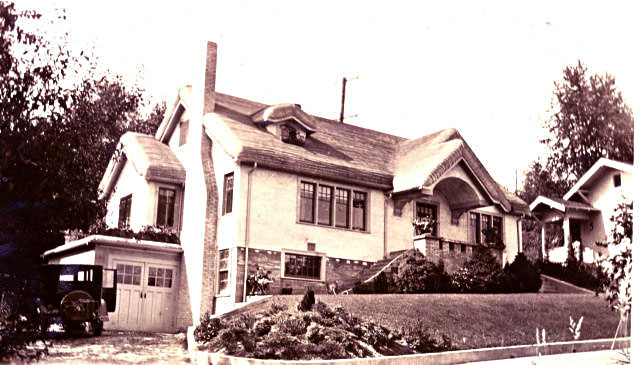
The Spriestersbachs built a large number of homes in Everett starting as early as 1907. An ad in the 1926 Polks states: "Spriestersbach Realty Estate, Loans, Rentals and Mining Property, Home Builders on Monthly Payments, 201 Spriestersbach Bldg, 2919 Wetmore Ave."
Houses they built in the north end typically had hip roofs with open rafter front porch roofs accented with heavy timbers. Fireplaces were common and chimneys were more elaborate than most houses with flared corbels or fancy brick work. Houses tended to be quaint with a lot of personality, no two being quite the same. List of Spriesterbach Houses Jack O'Donnell research.
Staff Sergeant Jack W. Spriestersbach, son of Elwyn N. Spriestersbach died June 1944 in the Philippines The Polks list Cora as a widow in 1950. She died before 1958. Some of their relatives continued the business, including E.W. and Medora Spriestersbach, continuing until at least 1978.
This house was used in the TV series "Twin Peaks", as the home of the Palmers. See Jul 5, 2014, Oct 9, 2015, Nov 14, 2017 Herald articles.
Fred Schoch was district manager for Northwestern Mutual Life Ins. Co. of Milwaukee in 1926. He died in 1929. See also Everett Herald, April 9, 1924. Kitchen remodeled in 1974.
Ossian and Mabel Anderson lived here starting in 1930. Ossian was president of Puget Sound Pulp & Timber Co. on Federal Ave at the foot of 26th St (later the location of Kimberly Clark). He died by 1944, and Mabel lived there until about 1965. In 1967 Peter and Marilyn Pettersen lived here. Peter worked for Carl Gibson's Enco Service and later Carl & Pete's Used Car Sales, then later for GM Sales and British Motor Co, Everett Sports Cars (president by 1984), president of Everett Jaguar Volvo, retired by 1986. They remained until about 1990.
On May 13, 2000, the City of Everett Historical Commission presented Gene Fosheim with a Letter of Commendation for rehabilitation of the historic home. It was a 1906 Queen Anne style house in a Classic Revival form which was unique in Everett. It had a great band of scalloped machine shingles running around the base of the second floor. One historian said, “It was the most unusual vernacular style residence in the Port Gardner Neighborhood.”
It was sold to Compass Health in 2005, who tore it down a couple of years later. Gene Fosheim
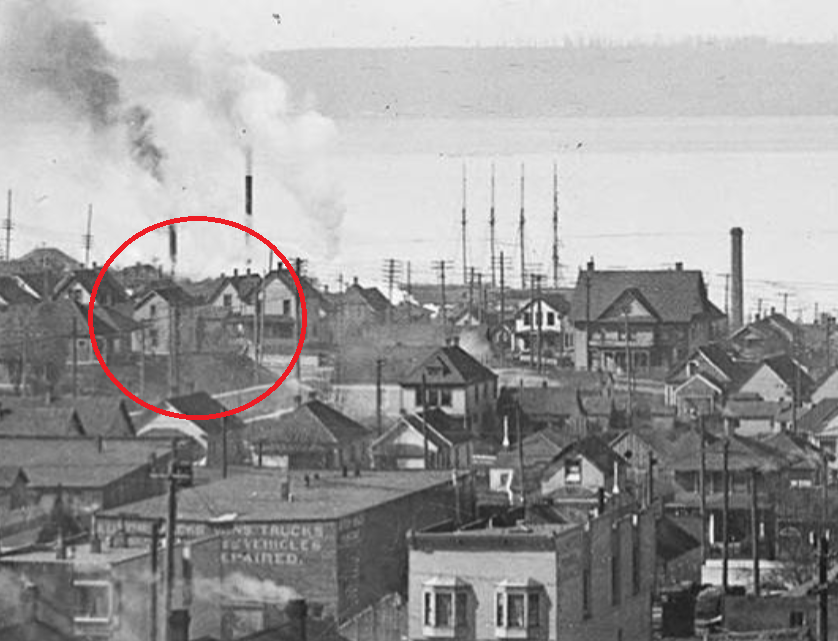
The house was built for Alexander and Harriette MacReady. Alexander, born in Scotland, was a real estate insurance executive. Harriett was born in Pennsylvania. The couple married in July of 1898, and the water hookup was applied for by Alexander in September of the same year. MacReady went on to found MacReady and McRae, a real estate insurance firm. The MacReadys remained at 3001 until 1916, and apparently still owned the house in 1925.
Tragedy struck the family of Clarence Winkley, when the longshoreman was discovered drowned in 1927. He had been partying on a float
The next long-term resident after the MacReadys were Frederick and Mary Burke, who were there from 1928-1933. Frederick was a shipbuilder for American Tug Co. From 1937-1944 there was a quick succession of temporary residents.
In 1944, Dorothy and Earl Bray moved in, and would remain until 1985. Dorothy worked for years as a saleswoman at Sears Roebuck and Company. Earl was a millworker who worked for Weyerhaeuser, Walton, and Summit mills. Later he transitioned to working with the County Road Department as a laborer - a job he retired from in the late 1970s.
After the Brays the home appeared to spend some time as a rental property. In 2002 it underwent some significant renovations. The ½ second floor on the north end was dormered to create a full second floor with master suite. The south wall was extended to connect with the detached garage (making it part of the main structure), and a kitchen and laundry room was added to that new space.
Research by Lisa Labovitch
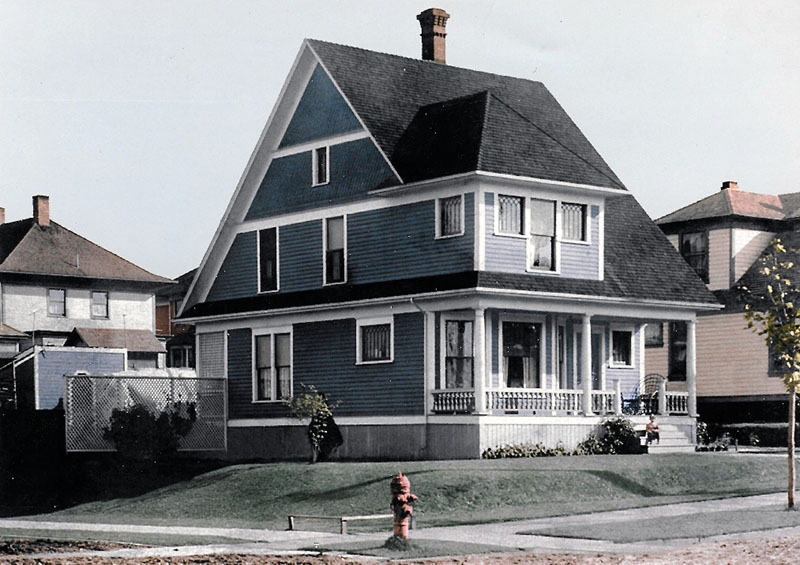
Built by Spriesterbach.
Alexander Keay immigrated from Scotland to Everett in the late 1800's. Amy McGhie Keay and many of her siblings immigrated at about the same time from Ontario Canada. Alexander worked for several of Amy's brothers at their meat packing company, where he met Amy. They bought the house at 3201 Norton in about 1906.

Story and research by Bart Keay Triesch
Alexander was well known and popular in Everett and in 1908 he was voted City Treasurer. In 1911 Amy went back east to attend the funeral of her mother. When she returned, her husband was missing. There was much speculation that perhaps he disappeared while on a hunting trip. However, it soon was determined that a large sum of money was missing from the city's treasury.
Alexander had embezzled between $19,000 - $23,000 from the city (about $500,000 in 2019). See Herald, Dec 6-7-8-11-14-22, 1911 stories. Despite that Pinkerton detectives searched for Alexander's whereabouts, he was never seen again.
Amy and her two sons went on to live alone at 3201 Norton. Amy died in 1952 at the age of 86. Alexandria Keay Triesch was born in 1921 in the bedroom that extends over the front porch at 3201 Norton.
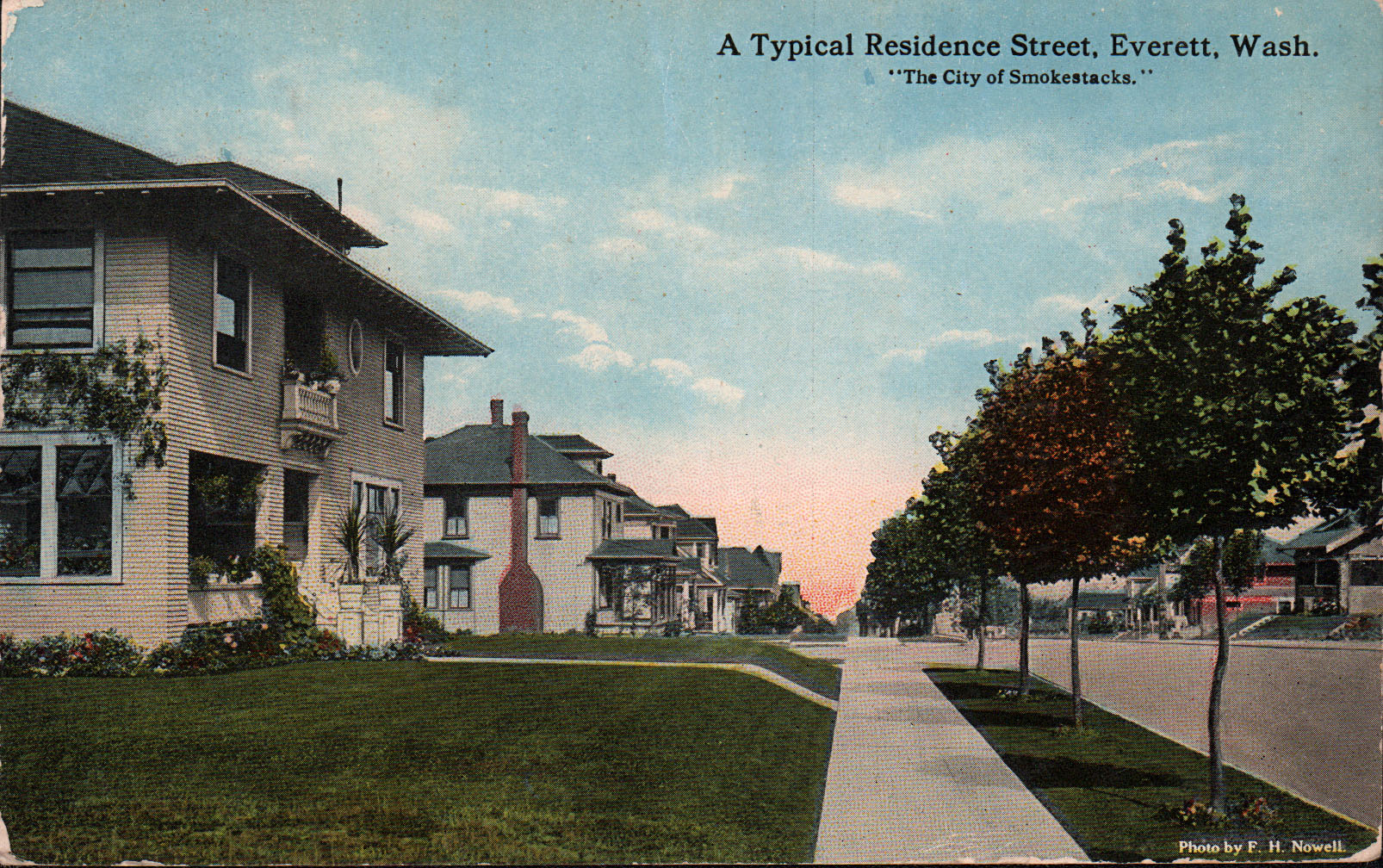 A view of the 3300 block of Norton looking north in the 1910s.
Boner-Weyerhauser house, the Wight house (daughter), the Peglow and Hull houses.
Edward Wight married one of the Boner girls.
Dave Hull married Virginia Peglow.
What a neighborhood, eh?
Jack O'Donnell collection
A view of the 3300 block of Norton looking north in the 1910s.
Boner-Weyerhauser house, the Wight house (daughter), the Peglow and Hull houses.
Edward Wight married one of the Boner girls.
Dave Hull married Virginia Peglow.
What a neighborhood, eh?
Jack O'Donnell collection
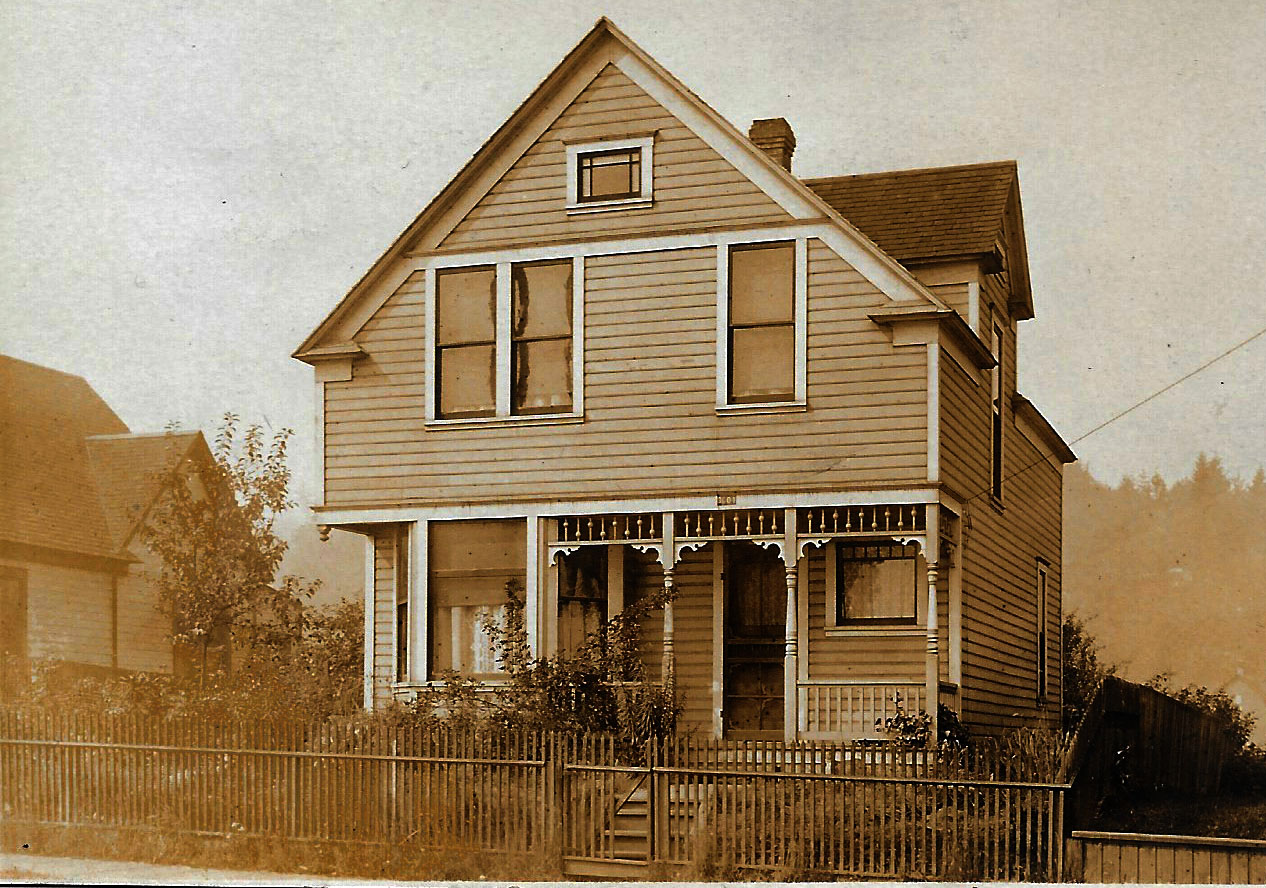
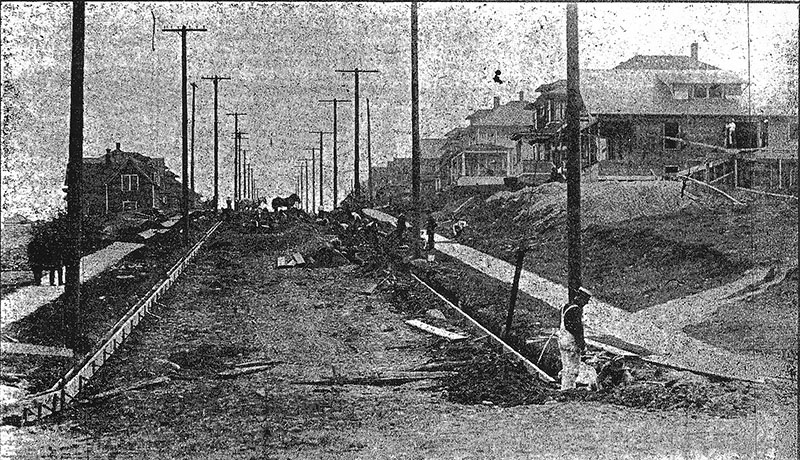 The 3100 block of Grand Ave, looking south from Pacific Ave.
Ed Morrow collection
The 3100 block of Grand Ave, looking south from Pacific Ave.
Ed Morrow collection
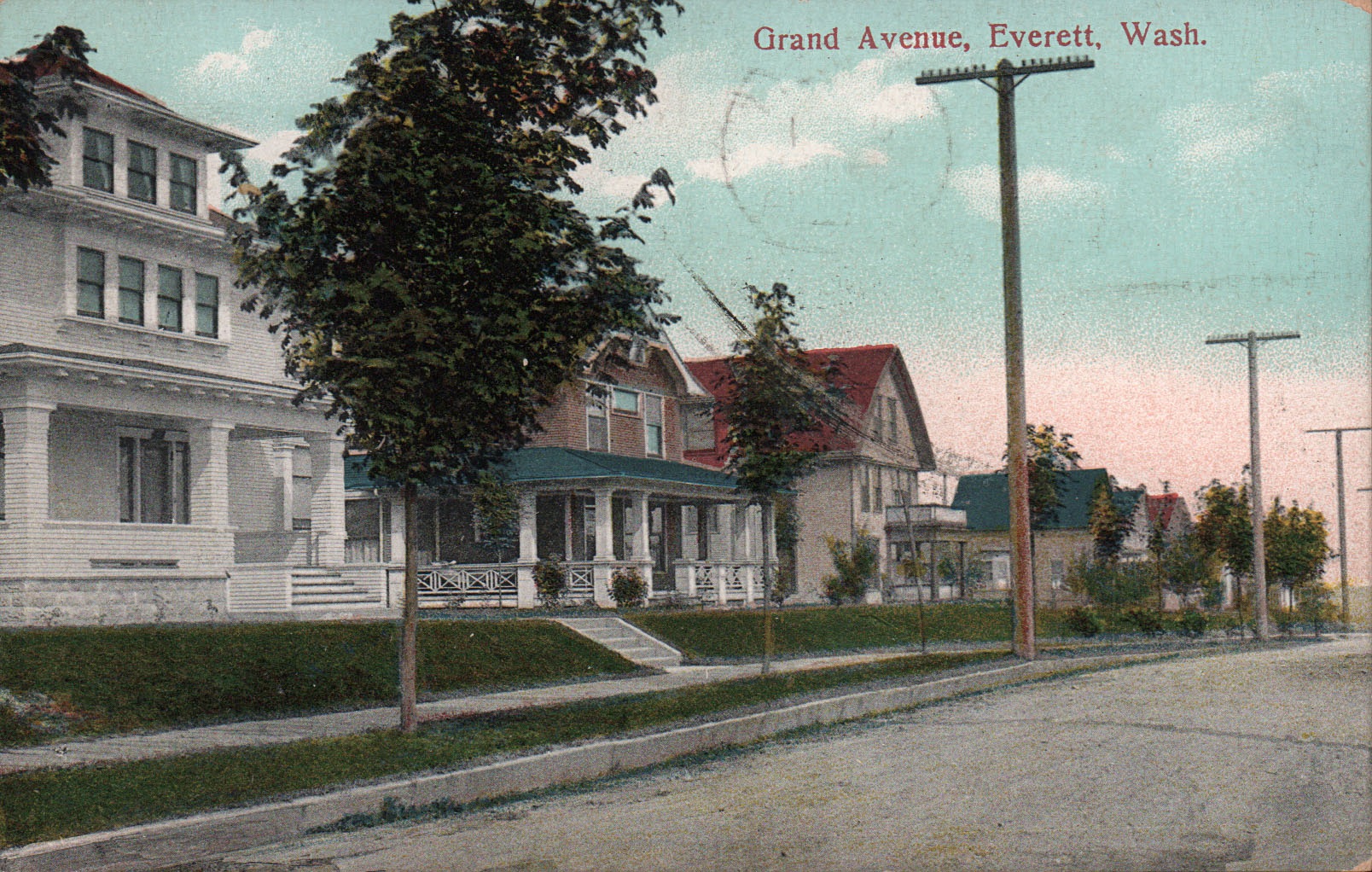 Truly Grand homes: the Stuchell house at 3316, the Shumacher house at 3310, the F.R. Pendleton house at 3304,
and the Friday-Caldbick house at 3232 Grand.
Helen and Edna Carpenter Stuchell married Dean and Glenn Carpenter next door at 3310 Grand.
Jack O'Donnell collection
Truly Grand homes: the Stuchell house at 3316, the Shumacher house at 3310, the F.R. Pendleton house at 3304,
and the Friday-Caldbick house at 3232 Grand.
Helen and Edna Carpenter Stuchell married Dean and Glenn Carpenter next door at 3310 Grand.
Jack O'Donnell collection
 A view looking north from a 1910 postcard mailed from 2514 1/2 Grand Ave.
Jack O'Donnell collection
A view looking north from a 1910 postcard mailed from 2514 1/2 Grand Ave.
Jack O'Donnell collection
Two junior high schools were built in 1925 for Everett's expanding student population. Everett High School was bursting at the seams with students. Issuing the largest bond thus far by the school district, construction started in 1925, with North Junior High completed shortly before South Junior High that year.
The calendar could be 1929, 1935, 1940, 1946. Later on the store was run by Ralph Korsborn, and called "Ralph's". Torn down for a gas station.
This was one of the earliest hospitals in Everett, started by Dr. Electra Rossman Friday in 1904. An earlier hospital had closed due to financial problems. Dr. Friday operated it until passing away in 1916, then her sister Miss Julia Gould operated it until 1924 when it became apartments. Everett General Hospital started in 1924 near by. The hospital grew to use four houses, connected with corridors. After that use they were again separated. The main house became a rest home. In 1974 it was torn down for a new rest home building.
Nathan and Addie Butts and her mother Rachel Wolfley moved into their new house here, from 3204 McDougall Ave. They lived here until about 1928. Rachel Wolfley, born in 1836, married civil war veteran Robert Wolfley, and died Feb. 8, 1911. She was President Barack Obama's great great great grandmother. Herald article. Nathan and Addie Butts died in the mid 1930s. The three are buried next to one another at Evergreen Cemetery
The house was at the rear (east) part of the lot, according to the 1914 Sanborn. Another house was built at the front, probably in the 1920s or 1930s. The two were addressed 3611 and 3611-1/2 Hoyt Ave. The rear house was removed about 1998 after a fire.


 Jack O'Donnell collection
Jack O'Donnell collection
C. Oliver Martin was a general agent and chief clerk for Northern Pacific. By 1947, the Glenn O'Donnell family lived there. Glenn O'Donnell was a real estate agent. The O'Donnell family were there until 1965.
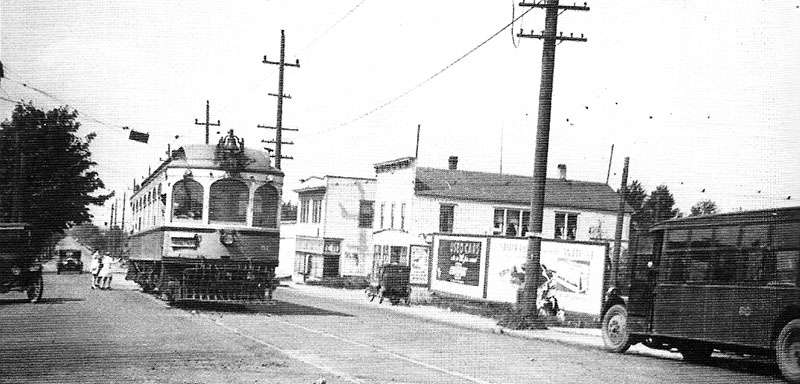 Looking north on block of Colby from 41st St, with the Interurban car.
Walt Shannon collection
Looking north on block of Colby from 41st St, with the Interurban car.
Walt Shannon collection
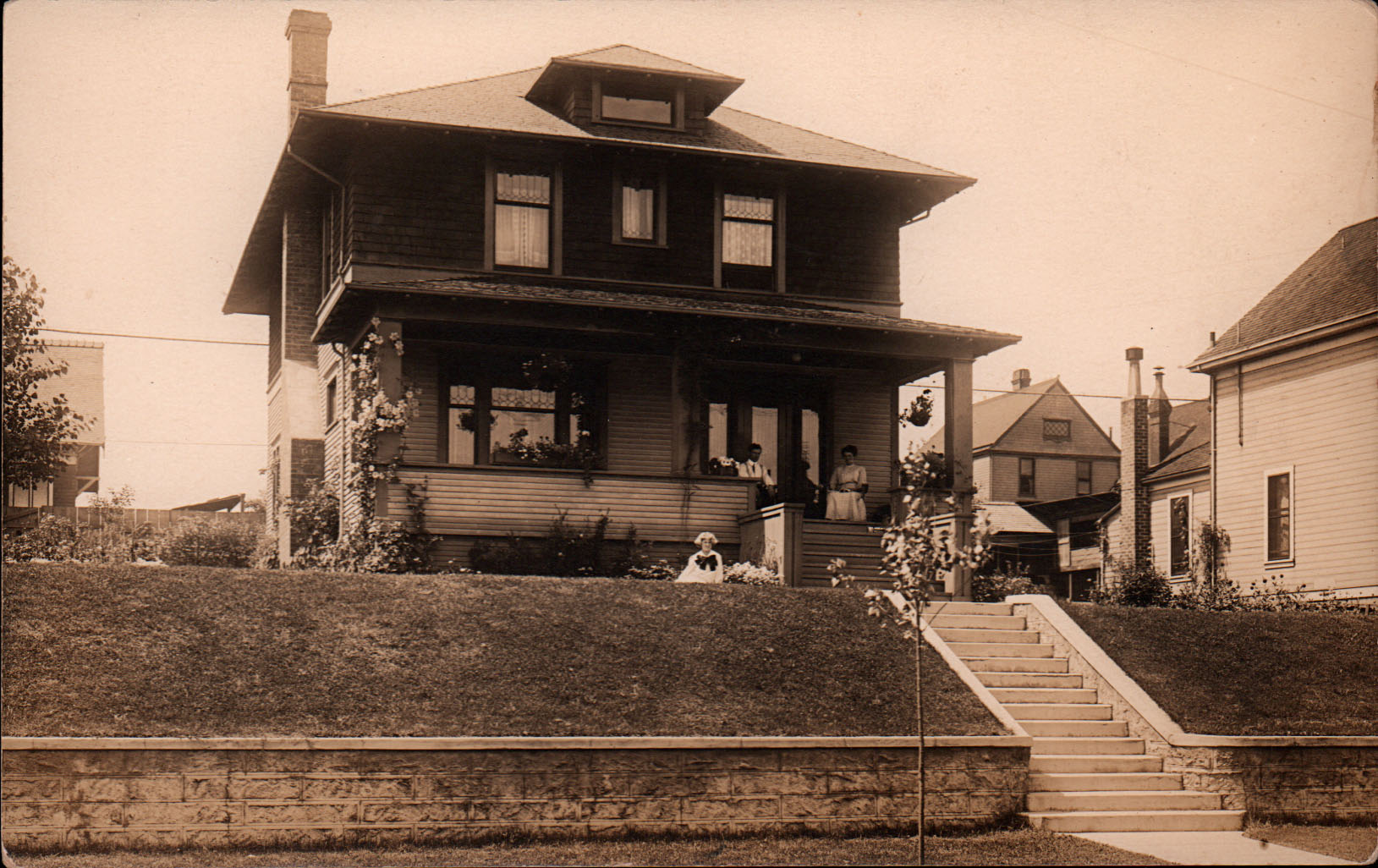 Jack O'Donnell collection
Jack O'Donnell collection
 Mrs. Bellrood's house.
Jack O'Donnell collection
Mrs. Bellrood's house.
Jack O'Donnell collection
Built for S. Knowleton in 1892. Noah Shakespeare, an Everett booster, attorney, judge and a veteran of the Spanish American War, was here by 1920. By 1955 they were rentals owned by Lulu Shakespeare. Demolished in 1987.
Kore, Maggie, Agnes Duryee lived here. By 1944, Georgina and Winnefred McKinzie, school teachers owned it. The house and barn, owned by H.T. Newton, were demolished in 1983.
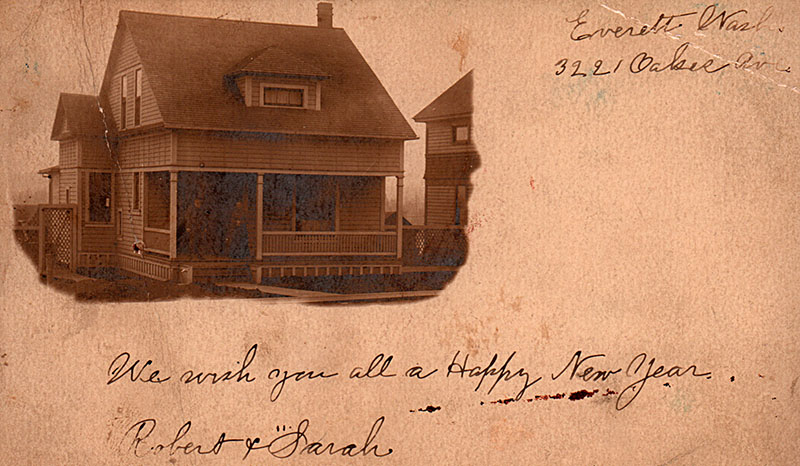 Robert and Sarah from a postcard.
Jack O'Donnell collection
Robert and Sarah from a postcard.
Jack O'Donnell collection
1926-37 Willis S. and Rose E. Friend, he a constable. 1941 Joseph O. and Anna M. Bolger, He was secretary of Townsend Headquarters. 1944-55 Thomas C. Tollefson, longshoreman. 1958-68 Raymond A. and Lorna Dowd, he a millworker or cutter boxman at Weyerhaeuser, she a clerk at Tyee Aircraft. 1986-2020: law ofices. 2020: slated to be demolished.
Austin Wintermute through at least 1907, carpenter; Elizabeth Wintermute; Luella Wintermute. 1930-35 Lillie V. Boomer (widow of John M.); Ernest M. Boomer, Super Shingle Service Co. John M. Boomer logger. 1937 Samuel A. and Elsie M. Symmonds, He was an engineer. 1939 Elliott M and Emma Hall, He was a blacksmith 1941-50 Marion C. (US Army, construction worker, bridge superintendent) and Evelyn N. (teacher at Rosehill El.) Freeman; Dorothy B., student, r; George F., student, r; Robert E., r. 1952-53 John F. and Ladene Chiamulera, he manager Sears Roebuck and Co. 1957-59 John K. and Sylvia Gudjonson, he with Thornberry Motors. 1965-70 Ralph E. and Judith Petitclerc, Lynn, Matt; he a crane operator at Weyerhaeuser.
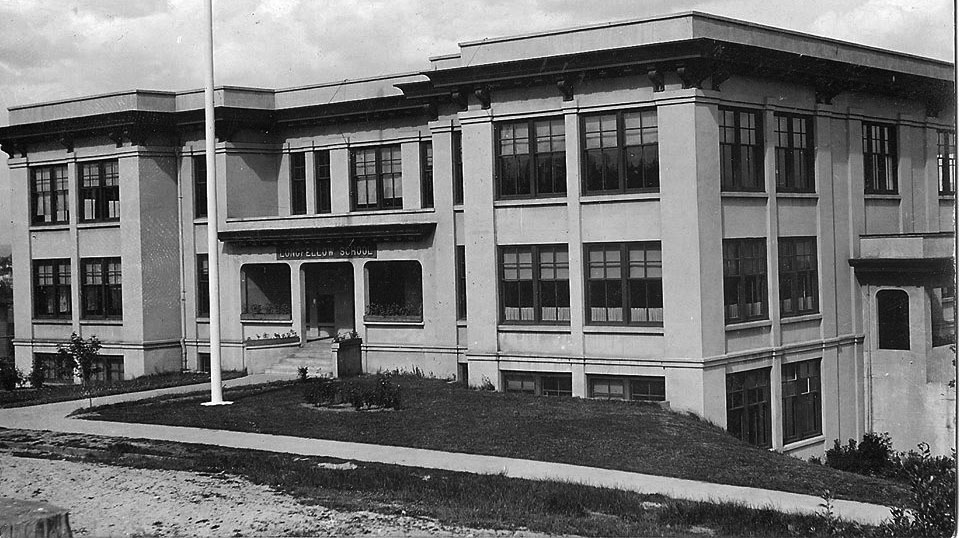
Longfellow School, 3715 Oakes Ave, built in 1911. The new school, designed by Wesley R. Hastings and built by R.B. McAdam, was erected for about $38,000. Its design reflected a subdued vernacular version of the popular Beaux Arts Classic style with symmetrically placed windows and a decorative cornice as part of a pronounced entablature. The 12-room concrete structure was faced with a stucco finish. The district broke tradition by naming the school for a literary figure instead of for a U.S. president. Later other city schools were named for poets.
Important alumni include Senator Henry M. "Scoop" Jackson, and Stan Boreson.
As of this writing (Feb 2017), Longfellow School is in jeapordy of being torn down for a parking lot. Longfellow School was used for students from 1911-1971. Later it was the administration building for the Everett School District. More information on Longfellow School.
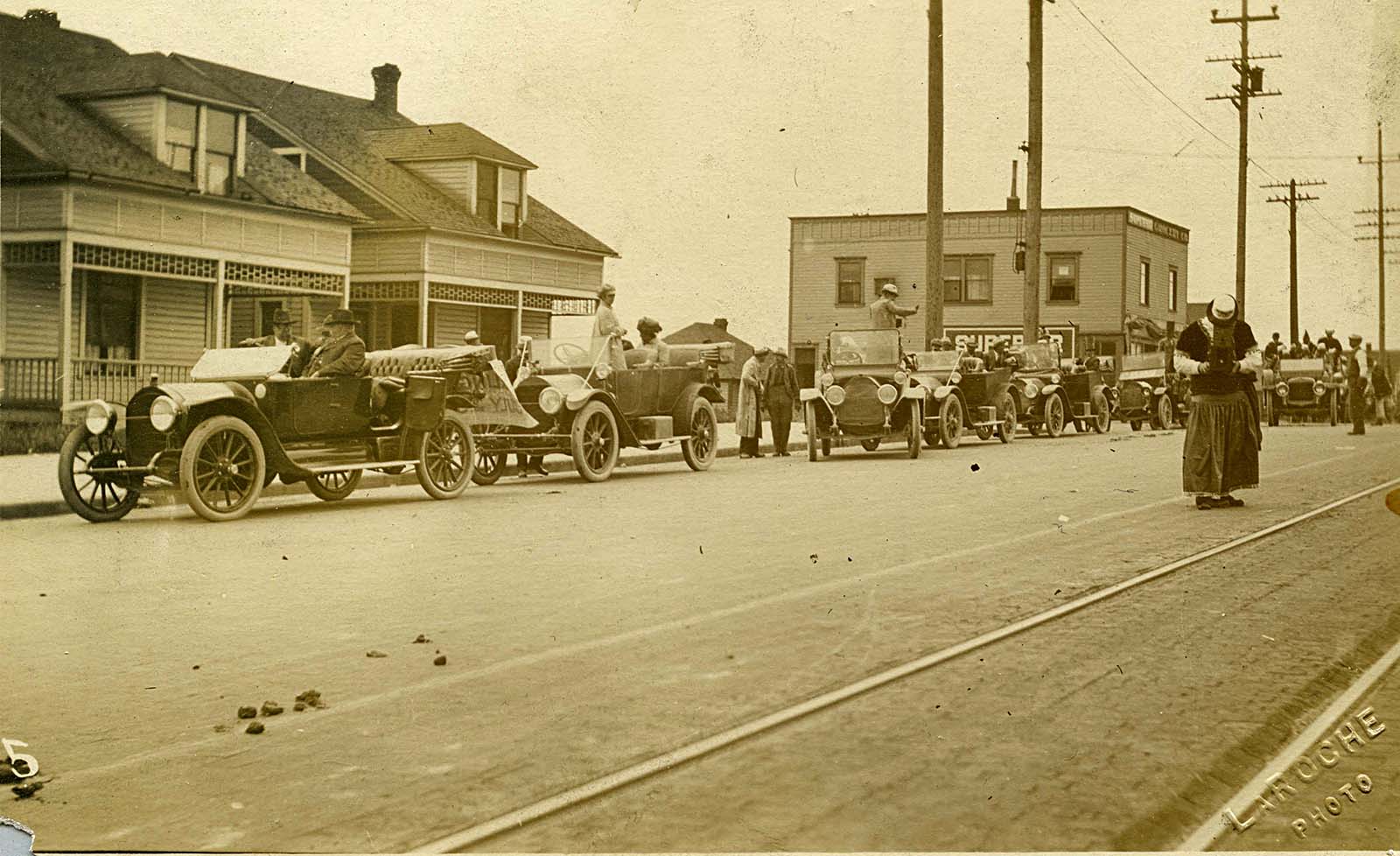
The Superior Grocery, right side of the picture, was at 3101 Broadway. operated by E.P. McPhall, president; William F. and Jessie G. Porter, treasurers, and Edwin M. and Myrtle B. Ellis. Later only Roy A. Hyatt was listed – as manager. Possibly living in upstairs quarters at the time were Jesse and Elinor McClure. At one point he was a machine tender at Everett Pulp and Paper and she a dressmaker working out of the home.
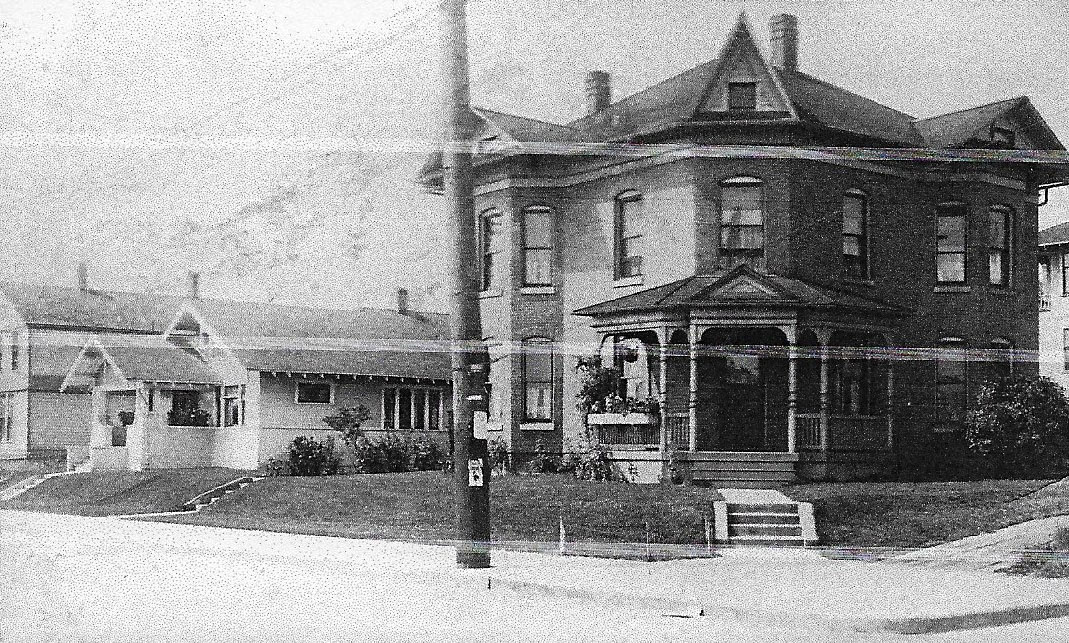
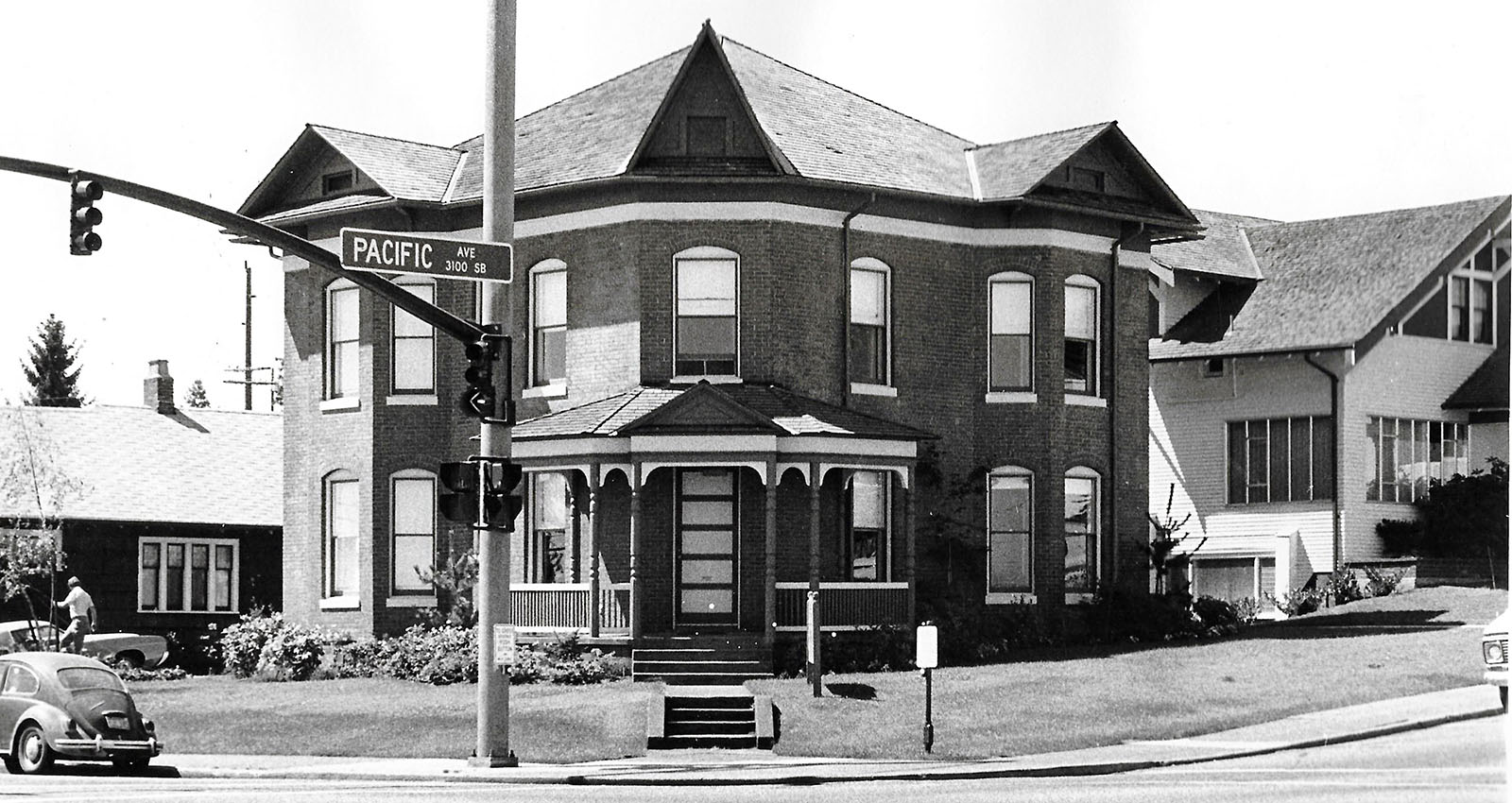
Addressed as 2020 Pacific in the early years.
Wasson owned a brick company about where Memorial Stadium is today, which is why this is one of few houses built with brick in those days. The building has been a credit union since at least 1978.
Alexander Kick built the bottling works in the 1925. Originally there were eight apartments on the second story. By the 1960s it was the Pepsi Cola Bottling Company of Everett, including Nesbitts Orange and Hires Rootbeer. It was King Size Photo in the 1970s, which became a medium-sized chain. Jim Haugen, owner, decided not to compete with large chains, and downsized to one store called Crown Image (see May 7, 1985 Herald article).
The area of the stadium and parking area was once a wetland and had a brick yard near by to the south.
The school district discussed and planned for years for a new athletic complex. The Everett Elks Lodge No. 479 donated land for the stadium in 1947, dedicating it to Everett men who died during WWII. Rushing to complete before the end of the football season, the grandstand was built by Associated Sand and Gravel of Everett, owned by EHS grads Howard Sievers and George Duecy. The stadium roof was built by Newland Builders, owned by EHS grads, the Newland family. On November 1, 1947, Governor Mon Wallgren gave the dedication address, and the first game for the stadium was Everett vs. traditional rival Bellingham. The Seaguls won the game
In the 1960s, the stadium roof was built by Newland Builders, owned by EHS grads, the Newland family. In 1981, a new fieldhouse, named for longtime coach and athletic director Jim Ennis opened. The all-weather track and press box were added in the 1980s.
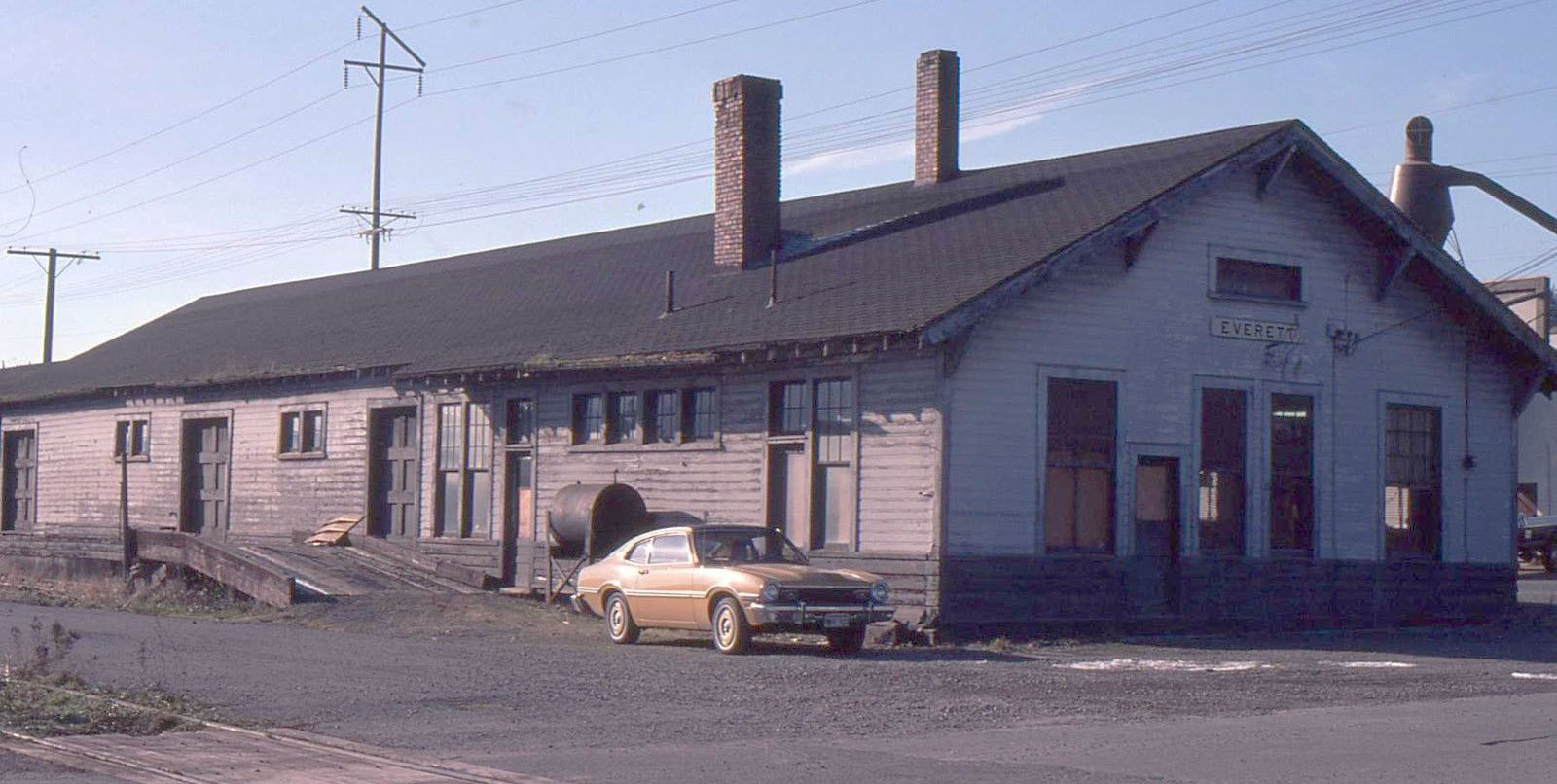 Jack O'Donnell collection
Jack O'Donnell collection
Smith Ave was named for E.D. Smith, who founded Lowell in 1863.
We hope you enjoyed your walking tour of the Port Gardner neighborhood! For more tours, see Historic Everett walking tours. Write us below if you have comments, more history, or questions.
Updated: 05/01/2025
Thanks! Historic Everett.